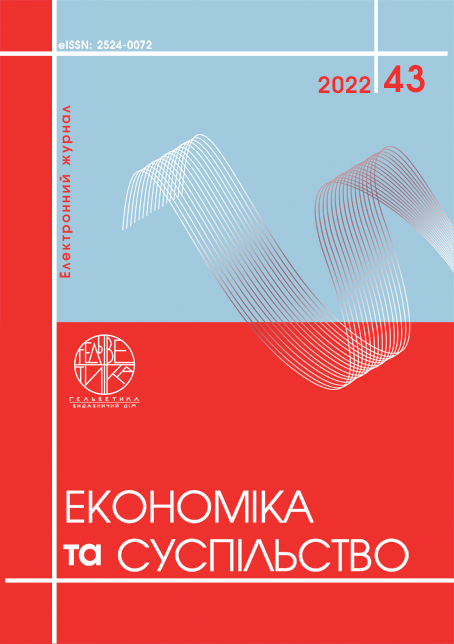THE CHARACTERISTIC OF MAIN PROBLEMS OF PROVIDING INFORMATION SECURITY UNDER THE INFLUENCE OF DIGITAL TECHNOLOGIES
Abstract
The study was aimed at characterizing the main problems of ensuring information security under the influence of digital technologies. The paper proved the importance of analyzing the main problems of ensuring information security of socio-economic systems in the conditions of digitization and military realities of nowadays. The article was aimed at researching the main problems of ensuring information security under the influence of digital technologies, and their characteristics and researching other types of threats that have formed at this stage. A set of general theoretical research methods served as the research implementation methodology. It is about the use of methods of theoretical analysis and synthesis, deduction, theoretical generalization and the modeling method. As a result, the key problems of ensuring information security under the influence of digital technologies, and war and military threats to information security were identified. An analysis of the provision of information security by representatives of Ukrainian business, in particular the financial sphere, at the beginning and during military operations on the territory of the state was carried out. The main problems in the field of ensuring information security of organizations and enterprises have been identified. The reasons contributing to their appearance are singled out. A theoretical model for countering threats to the information security of the enterprise has been developed. The algorithm for building the model consisted in: determining the main elements of the model for countering threats to information security at the enterprise and their characteristics; the development of pre-modeling stages, which made it possible to form a preparatory basis for the model itself and to answer the question of relevance and the need to counter threats to the provision of information security at the enterprise; formation of the very model of ensuring information security at the enterprise. Some recommendations have been developed to solve the main problems of ensuring the information security of the enterprise. The expediency of forming a response model to the problems of ensuring information security for a separate socio-economic system was proposed and substantiated.
References
Maček, D., Magdalenić, I., Ređep, N.B. A systematic literature review on the application of multicriteria decision making methods for information security risk assessment. International Journal of Safety and Security Engineering. 2020. Vol. 10, No. 2, pp. 161–174. DOI: https://doi.org/10.18280/ijsse.100202
Fenz, S., Ekelhart, A. Verification, validation, and evaluation in information security risk management. IEEE Security & Privacy. 2011. № 9 (2). P. 58–65. DOI: https://doi.org/10.1109/MSP.2010.117
Pan, L., Tomlinson, A. A systematic review of information security risk assessment. International Journal of Safety and Security Engineering. 2016. № 6(2). P. 270–281. DOI: https://doi.org/10.2495/SAFE-V6-N2-270-281
Eren-Dogu, Z.F. & Celikoglu, C.C., Information security risk assessment: Bayesian prioritization for group decision making. International Journal of Innovative Computing, Information and Control. 2012. № 8. P. 8001–8018.
Wei, G., Xhang, X., Zhang, X. & Huang, Z., Research on e-government information security risk assessment-based on fuzzy ahp and artificial neural network model. Networking and Distributed Computing (IC-NDC), First International Conference on, IEEE. 2010. P. 218–221. DOI: http://dx.doi.org/10.1109/icndc.2010.52
Roy, A., Gupta, A. & Deshmukh, S., Information security risk assessment in SCM. Industrial Engineering and Engineering Management (IEEM). International Conference on, IEEE. 2013. P. 1002–1006. DOI: http://dx.doi.org/10.1109/ieem.2013.6962561
Maček, D., Magdalenić, I., Ređep, N.B. (2020). A systematic literature review on the application of multicriteria decision making methods for information security risk assessment. International Journal of Safety and Security Engineering. Vol. 10, No. 2, pp. 161–174. DOI: https://doi.org/10.18280/ijsse.100202
Fenz, S., Ekelhart, A. (2011). Verification, validation, and evaluation in information security risk management. IEEE Security & Privacy, no 9 (2), pp. 58–65. DOI: https://doi.org/10.1109/MSP.2010.117
Pan, L., Tomlinson, A. (2016). A systematic review of information security risk assessment. International Journal of Safety and Security Engineering, no 6(2), pp. 270–281. DOI: https://doi.org/10.2495/SAFE-V6-N2-270-281
Eren-Dogu, Z.F. & Celikoglu, C.C., (2012). Information security risk assessment: Bayesian prioritization for group decision making. International Journal of Innovative Computing, Information and Control, no 8, pp. 8001–8018.
Wei, G., Xhang, X., Zhang, X. & Huang, Z. (2010). Research on e-government information security risk assessment-based on fuzzy and artificial neural network model. Networking and Distributed Computing (IC-NDC). First International Conference on, IEEE, pp. 218–221. DOI: http://dx.doi.org/10.1109/icndc.2010.52
Roy, A., Gupta, A. & Deshmukh, S., (2013). Information security risk assessment in SCM. Industrial Engineering and Engineering Management (IEEM). International Conference on, IEEE. pp. 1002–1006. DOI: http://dx.doi.org/10.1109/ieem.2013.6962561


